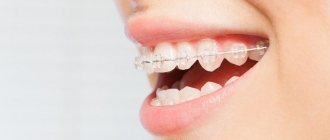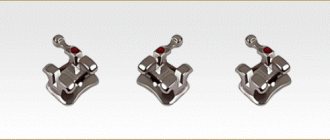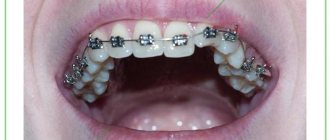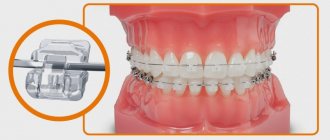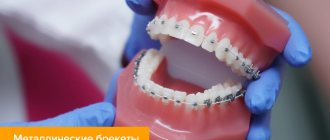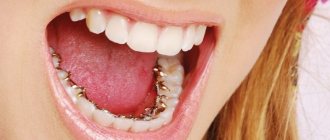Modern orthodontics allows you to correct the bite and straighten teeth not only for children and adolescents, but also for adult patients with a long-formed dental system. Today we can help people who, at the age of 30–40, are embarrassed by their smile and cover their mouths with their hands when laughing, and sometimes experience more significant problems caused by malocclusions.
Unfortunately, not every one of them agrees to undergo orthodontic treatment. It is difficult to decide to install turnkey braces on the outside of your teeth because they will attract the attention of strangers when communicating. And lingual braces, fixed on the side of the tongue and completely invisible from the outside, change diction, causing a lisp.
If you have already internally decided to correct your bite with braces, pay attention to the so-called aesthetic brace systems. They do not straighten teeth as quickly as classic metal ones, but they effectively cope with the majority of not the most complex malocclusions and are not at all noticeable.
What is this system?
This name is given to bracket systems, the base of which is made of artificially grown sapphire crystals. At its core, the material is monocrystalline aluminum oxide.
Despite the “artificial” nature, this material does not cause allergies and is completely safe for the human body . It can be classified as ceramics. The difference between sapphire and ceramic braces is that polycrystalline aluminum oxide is used to produce the latter.
For crystallization (“crystal growing”), the starting material is exposed to very high temperatures – 2050°C. After special cutting and polishing, braces have the ability to transmit light . This is what makes them transparent and invisible after installation.
During the cutting process, each element is given a rounded shape, which allows the patient to practically not feel the foreign structure in the mouth, since it does not damage the mucous membrane .
How are clear sapphire braces made?
Thanks to the development of technology, scientists have learned to quickly grow crystals in laboratory conditions with given physical characteristics, similar to natural crystals that have been growing for thousands of years. Artificially grown minerals found application first in jewelry (colored sapphires) and in the watch industry, and then in orthodontics (perfectly transparent colorless sapphires).
- In terms of hardness, sapphire locks are second only to diamond, and in terms of aesthetics they are quite comparable to it, since they have the appropriate coefficients of reflection and refraction of light.
- When in contact with saliva, they completely merge with the teeth.
- The special cut of the crystals makes sapphire braces a stylish dental decoration and at the same time minimizes the likelihood of injury to the soft tissues of the oral cavity.
- Due to their minimal thickness, they do not cause the unpleasant sensation of protruding lips.
- In the rays of neon lighting of nightclubs, artificial sapphire does not glow and therefore does not catch the eye at all.
Device and principle of operation
Not only the device, but also the principle of operation of such systems are identical to classic braces made from other materials.
The system consists of three main elements:
- The first is the braces themselves. They are miniature locks that have wings and a groove for the arc.
- The arc is the main active component. After its installation (passed into the groove of each lock), the braces are connected into a single system.
- Ligatures are small fasteners that help hold the archwire in the groove.
The principle of operation is based on the fact that the teeth in the jaw are fixed in such a way that they can slightly change their position. Moreover, the change is possible in any direction - towards neighboring teeth or around the central axis - if constant and prolonged slight pressure is applied to the tooth.
The arc is made of a material that has so-called shape memory - it tends to take its original position .
It is she who produces this pressure, gradually changing the position of each desired tooth.
Main disadvantages
These orthodontic devices have very few disadvantages compared to other types of braces.
Minuses:
- The first and most significant of them is high cost. To a greater extent, the complexity of production and processing of each bracket and the need to use expensive equipment play a role here.
- A fairly long period of bite correction with the help of these systems.
- Despite the high strength of the base material, it is very fragile, forcing patients to treat the installed device very carefully.
- They are practically not used to correct serious malocclusions.
Classification of ceramic products
Ceramic braces are divided into two groups:
- Polycrystalline.
- Monocrystylic.
The most popular are the first ones, that is, polycrystalline systems, characterized by the dullness of the coating and the ability to fully replicate the color of the teeth. Their use, however, is not always possible, since matte structures are not always suitable for a particular patient.
Monocrystalline braces are more transparent, they actually completely match the color of the enamel and are more comfortable, but they are fragile, susceptible to damage and take longer to operate.
Manufacturers
These orthodontic appliances are made by different manufacturers.
Inspire ICE from Ormco
They take into account all the shortcomings of previous generations, so Inspire ICE are deservedly popular.
photo: before and after treatment
The special platform of each bracket has a special coating of microscopic zirconium balls , which, when applied with an adhesive, create maximum adhesion force to the tooth. At the same time, the properties of the coating make it easy to remove braces after treatment.
Damon Clear
This is a self-ligating passive system that has several advantages. In particular, this concerns the design. First of all, we should note the diamond shape and rounded edges, which increase wearing comfort. Using this system, there is no need for frequent visits to the dentist to activate the archwire.
photo: before and after
The groove is closed using a special patented Spin Tek mechanism, which allows the necessary manipulations (replacement of the arc) to be carried out quickly and without causing discomfort to the patient.
When opening the lock there is no pressure on the tooth. The attachment to the enamel surface is very strong and reliable , thanks to laser etching of the bracket base.
Miso
Also a non-ligature system, the difference of which is the free fixation of the arch without blocking it. This is achieved thanks to the presence of special sliding clamps in the design, which are similar in appearance to a valve.
This type of fixation simplifies the correction and allows you not to visit the orthodontist too often, and also facilitates care.
Radiance from American Orthodontics
The main advantage of this classic ligature system is the special base of each bracket, which has a patented name “Quad-Matte”.
Its peculiarity is that along the perimeter the attachment to the enamel is much weaker than in the central part. This ensures the safety of the enamel and ease of removal without damaging the teeth or using special tools.
Pure by OrthoTechnology
They are distinguished by their neat shape, miniature size and fastening strength , which is ensured by applying powdered zirconium dioxide to the base of each element.
photo: treatment result
The installed system looks like a decoration, as it transmits not only natural daylight, but also neon. Because of this feature, it is suitable for active young people.
Ligature and non-ligature
Sapphire braces can be made in two types.
The classic case is when the system is equipped with ligatures to hold the arc - fastenings that are small elastic bands or thin wire rings. Rubber ligatures wear out quite quickly , so they have to be changed by your doctor.
Non-ligating braces are also called self-ligating braces. They are radically different from ligature ones in their structure. Each bracket is equipped with a lock that snaps into place and firmly secures the archwire , allowing it to slide. In this case, no additional fastenings are required, and the friction force will be much less.
Self-ligating systems are more expensive and in many cases more effective, as well as easier to use - there is no need to change the ligatures if they change color, become deformed or break.
However, they are not always better. The fact is that during the treatment process it may be necessary not only to replace the arc , but also the density of its fastening. When the contact with the walls of the groove is loose, this is a passive type of fastening, and if the arc is fastened very tightly, this is an active type.
Sometimes you need to change the force on your teeth. In the case of a classic ligature system, this is quite simple - the doctor can slightly loosen the fastenings , allowing the arc to slide freely or vice versa.
But self-ligating systems can be equipped with only one (passive or active) type of fixation. This may affect the duration of treatment, prolonging it.
Duration of use
The duration of treatment is determined for each patient individually. No specialist will initially be able to say how many months you may need to walk with them. The treatment period is longer, how long they need to be worn, depends on the pathology, the age of the client, individual nuances of the structure of bone tissue, etc.
If the disorders are not complex, the treatment period can be within 8-10 months. Otherwise, correction may need to be carried out over several years. For example, a wide interdental gap can be reduced in about 6 months. Protruding fangs are leveled in 6-8 months, the bite is corrected in 1-2 years.
Orthodontic treatment with any type of braces requires patience and endurance. When used, average pressure is applied to the teeth, so they move no faster than one millimeter per month.
What arcs are used?
Unfortunately, there are no transparent arches that have the qualities necessary for braces. a classic metal arc is inserted into sapphire systems . It is a little noticeable during a conversation, but does not create the effect of “metal staples”.
In such systems, to maximize their aesthetics, you can use metal arches that have a white coating of a material similar to Teflon.
In this case, the braces become completely invisible. The only drawback of such arches is that the aesthetic coating can gradually wear off due to strong friction.
Let's sum it up
There is no clear answer to the question of which brace systems are better; there is no fundamental difference between them. If aesthetic considerations come first for the patient, then it is rational to give preference to transparent sapphire designs, but your choice should always be agreed with a specialist. For those who most value the wear resistance of the system and its reliability, ceramics would be the optimal solution; it is better to give it their preference, but even in this case, you first need to visit a doctor for a consultation.
There is no need to be afraid of installing braces; the treatment procedure will not cause any serious discomfort, but the result will allow you to fully enjoy life and not hide your beautiful and dazzling smile.
Which systems are better and how do they differ?
At the moment, most orthodontists agree that to correct significant malocclusions, the ideal option is to install a metal brace system.
This is due to its reliability, maximum strength and the ability to use large forces to move teeth. However, it has one significant drawback - the metal on the outer surface of the teeth stands out and spoils the impression of a smile.
As opposed to metal, special ceramics and artificially grown sapphire crystals began to be used in orthodontics. Both of these materials are less durable than metal, but are strong enough to perform their functions .
The option of sapphire artificial crystals is most preferable for those for whom the aesthetic side of the issue is very important, since transparency and high light transmittance make them invisible.
Ceramic braces have properties similar to sapphire ones, but have a matte tint , which will be noticeable on white enamel. The strength of ceramics is almost the same as that of a transparent crystal. In addition, both materials do not stain during wear and retain their ideal appearance throughout the entire treatment period.
Installation
Installation always takes place in several stages.
- Diagnostics. At the very beginning, the doctor conducts a complete diagnosis not only of the type of anomaly, but also of the entire oral cavity. Possible treatment options (for example, installation of a ligature or self-ligating system) are discussed with the patient. A visual examination is carried out, as well as detailed studies - orthopantomogram, photographs, etc.
- Preparation. Since the installation of sapphire braces can only be carried out on healthy teeth, the oral cavity is sanitized - all problems are eliminated (treatment of caries, other diseases) and professional hygiene is carried out.
- Taking impressions. Before making it, the doctor must take an impression of both jaws of the patient. This is necessary for making a working model and precise fitting of braces.
- Ordering braces and waiting for them to be made. The wait is inevitable, since in each case the installation is carried out purely individually - the location and shape of the bracket is determined for each tooth.
- Installation. In order to install braces, one visit is enough, but it requires from 1.5 to 3 hours of time spent in the dentist’s chair. The doctor secures each brace separately and only after that installs the arch
Price
The price of treatment usually includes:
- cost of sapphire braces for each jaw
- production according to individual parameters;
- diagnostics (orthopantomogram);
- work (installation, maintenance, removal);
- prolation;
- the cost of a permanent retainer (must be worn after the braces are removed).
By the way, you can find out what prices are for braces in CLINIK-PROFI ( CLICK ).
Whether to install sapphire braces is up to everyone to decide for themselves. The first thing that stops patients is the price of the pads. However, there is no need to skimp on your health. Choose a high-quality and aesthetic method of treatment. After its completion, your smile will become beautiful and your teeth will be healthy.
Next entry All about metal braces. Actually everything!
Who is it prescribed to?
Such orthodontic appliances are prescribed to patients who have relatively simple problems with the position of their teeth:
- malocclusion;
- spaces between teeth;
- torsion.
It is also important that people who may have allergic reactions to other materials can undergo treatment using such systems.
In this case, the age and gender of the patient (from 14 years old) do not matter. However, you should note that sapphire models are more suitable for patients with white tooth enamel . In the case of a natural yellowish color, aesthetics decreases, since the appliance becomes more noticeable on yellow teeth.
Rules of care
Despite the fact that sapphire braces do not change color while worn and are quite durable, there are still certain care rules that experts advise to adhere to.
- Be sure to brush your teeth every morning and evening.
- Use an additional toothbrush – a mono-beam one.
- Use dental brushes and, if possible, an irrigator.
- Avoid eating hard and very hard foods – nuts and other things.
- Be sure to visit a doctor according to the schedule for preventive examinations and replacement of arches.

